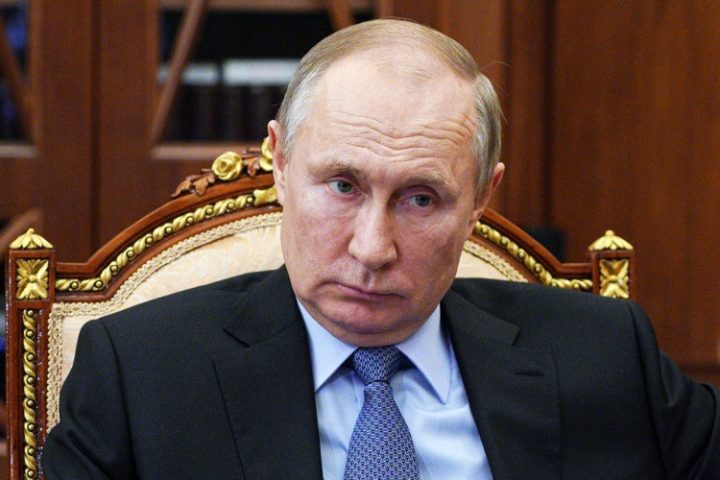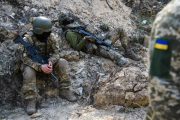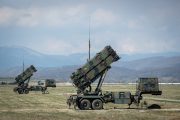
During the month of March, the Russian military activity has ramped up dramatically. Vladimir Putin is flexing his muscles, alarming his geopolitical neighbors.
Russia has started its war games and increased its military deployments in a couple of regions simultaneously. In the Arctic, it is building up military bases, hardware, and underground storage facilities, with bombers, MiG-31BM jets and new radar systems close to the Alaskan coast, according to satellite images provided to CNN by space technology company Maxar. As part of a recent major Arctic exercise, Russian ballistic-missile submarines surfaced next to one another from beneath the ice near the North Pole, and later Russia performed flyovers with heavy bombers, anti-submarine aircraft, and intelligence-collection platforms near Alaska, staying in Russian airspace “for hours.”
Tension is also building on the Russian-Ukrainian border, as Russia masses its military forces there. During the past week, the videos, pictures, and satellite images of Russian troops and military vehicles, tanks, fighters, and helicopters moving to Ukrainian border have flooded the media. An estimated 4,000 Russian troops have been dispatched to the border with the Ukraine, according to the New York Times. At the same time, the fighting resumed between Russian-backed separatists and Ukrainian soldiers in the Donetsk Region of eastern Ukraine, marking the end of a June 2020 ceasefire, and prompting the U.S. military’s European Command to raise its designation level of the situation to “potential imminent crisis” — the highest possible level.
The Kremlin does not deny the deployment and relocation of its forces, saying that Russian military movements near its shared border with Ukraine posed no threat to Ukraine or anyone else, and that Moscow moves troops around its country as it sees fit.
In light of the perceived bellicosity on the part of Putin’s Russia, European countries are expecting increased military support from the United States. Many may recall how fiercely Joe Biden and the Democrat Party appeared to stand for Ukraine — they even impeached President Donald Trump for an alleged quid pro quo involving a congressionally approved military-aid package meant to help Ukrainian President Vladimir Zelensky deter and ward off Russian incursions into his country’s territory.
Predictably, the United States stepped up. On April 1, the Biden administration warned Russia against “intimidating” Ukraine, with both Defense Secretary Lloyd Austin and Secretary of State Antony Blinken calling their Ukrainian counterparts to confirm their support. The next day, Kremlin spokesman Dmitry Peskov said that Russia would not hesitate to respond if the United States sent troops: “There is no doubt such a scenario would lead to a further increase in tensions close to Russia’s borders. Of course, this would call for additional measures from the Russian side to ensure its security.”
After coming under fire for his apparent inattention to Ukraine and rising regional tensions, President Biden got involved, too. He finally conversed with President Zelensky just recently, affirming his administration’s “unwavering support for Ukraine’s sovereignty and territorial integrity in the face of Russia’s ongoing aggression in the Donbas and Crimea.” It’s unclear whether this conversation was previously planned or was a reaction to bad press; the latter is more probable.
Following the conversation, Ukraine stated that joint military exercises with NATO troops may begin in a few months. The upcoming drills will involve more than 1,000 military personnel from at least five NATO member states, Reuters reported.
The situation seems to escalate day by day as a result of the verbal exchange and threats between the two sides. Will it result in more bloodshed in Ukraine and a new round of international confrontation?
Even though Ukraine and many Western observers warn that Putin may trigger a full-scale European war, there is ample evidence that this will not occur. As reported by the Institute of Study of Wars, indicators of looming large-scale offensive operations against Ukraine would be large-scale Russian force deployments and a likely NATO response. Russia’s front-line conventional units have not deployed at the brigade level or higher during ongoing readiness checks in Russia’s Southern Military District. Russia’s Western Military District has likewise not mobilized key regiments and divisions that would likely be necessary to support an offensive against Ukraine. The Institute has not observed or captured reports of the buildup of logistical supplies — including fuel, ammunition, and medical supplies — which would be necessary to support a major offensive. The United States, Ukraine, and NATO would almost certainly observe the preparations for a major offensive and issue far more strident statements than they have so far made.
Vladimir Putin often uses such saber-rattling on the eve of international talks. The threat of conflict and further deterioration in Russia-U.S. relations allow him to leverage his positions. The conflict in the region has already cost thousands of Ukrainians their lives, but this bothers Putin very little, as he is intent on asserting Russian regional dominance.
On the domestic front in Russia, Putin recently signed a law allowing him to serve two more terms. While he’s been ruling Russia since 1999, the country is dying, suffocated by enormous corruption and a crony capitalism that benefits only oligarchs and Putin himself. A narrative of the “NATO threatening the Motherland” may draw attention away from the pressing domestic issues.
Putin also may be trying to determine how far Biden is willing to go to support Ukraine. The annexation of Crimea and the Ukrainian conflict involving Russia-backed separatists happened during Obama’s tenure. The Obama administration provided the lion’s share of Ukraine’s military aid, but it was Trump who provided Ukraine with lethal weapons as a deterrent to Russian aggression. Biden has indicated that he plans to return to many Obama-era foreign policies, and is in Putin’s interest to determine how this will impact U.S.-Ukraine-Russia relations.




